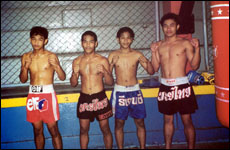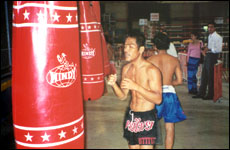 |
 |
 |
|
|||
|
Feature: Muay Thai Inside Rajdamnern Stadium the crowd is going wild. Most of them are standing up and waving their arms and shouting at two small, slender fighters in a rope-encircled, canvas-floored ring. One boy, and that's what he is, is in red trunks, one in blue. Both barefoot. One elbows the other in the ribcage. A knee flashes to what seems to be the groin of the other. They grapple with gloved hands and for a moment, seem to tear at eachother's faces. We have ringside seats Along with the few other foreigners, most of whom seem emotionally ill-equipped for this spectacle. Several times I have to turn away. Robert Montgomery of Bakersfield, California, watches unswervingly. He's obviously tougher than I am, but still seems a bit shocked. Montgomery: "I'm a fan of boxing in the United States. I find this sport very brutal. They don't have mouth pieces. I think a lot of these fighters will never see the age of 27 in this sport."
 Moore: "I like watching it because of the movement that goes along with the music, but what bothers me is that they're all so young to be risking their lives this way."They are young. In fact, most of the boxers are just teenagers. Muay Thai has traditionally been a way for poor country boys to break out of poverty. If they can win a championship, and survive their short careers without permanent injury, they might be able to get an education. But watching the frenzied pummling the youngsters are taking right now is painful. I'm wincing. It looks to me like neither of the boys will make it out of the ring in one piece. David Neeman disagrees. He's a Milwaukee neurosurgeon and an amateur Thai boxer, and says the sport is not as dangerous as it looks. Neeman: "There are a lot of ways to score points in this sport, and they don't all have to do with head blows. There's a lot of detailed strategy. The idea is to beat one's opponent with very skillful kicks with knees to the body. As a ringside doctor, I've been involved in 60 fights and several world championships. I've never seen a serious head injury or a neck injury."In the warehouse-like gym of the Muay Thai institute, faded, limp flags of the world hang from the ceiling. Below the flags are two long rows of sand-filled red punching bags suspended like giant salamis over a deli counter. Overhead fans twirl, impotent against the heat of the day and the rivulets of sweat on the beefy Europeans and slender Thai students thwaking knees, elbows, and fists against the stained leather. Charlie Guntari is a former Muay Thai champion. He's doing what many Muay Thai followers think is impossible, and what many training camps refuse to do: turning non-Thais, farangs, into fighters. Though Guntari's students, from Cyprus, France, and Greece, tower over him, he looks up at them like a tolerant dad. They do, after all, try hard. Guntari: "All Thai people they see the boxer fight before know how to kick, how to fight, how defend themselves but another country come..."Guntari tells me thais have been at this since they were little kids on the street playfighting. So farangs can get good, but for Thais, the knack to whack each other with such speed and force is second nature. That assessment doesn't bother Cypriot Chris Lazerilis. In Cyprus he's a computer engineer. Right now he's on the floor doing situps and grunting with the pain and pleasure of a man who has just been busted out of a life sentence of a sedentary day job. What a vacation! Lazerilis: "The best thing for me is it's like an army camp, because you get to live upstairs, get to live together with a lot of people. You get up early in the morning...not the email, no phone. And the best thing - my cell phone does not work in Thailand so nobody can bother me, and I don't get any calls."Forms of Muay date back to the 14th century, and vestiges of the ancient ritual that accompanied the old sport still exist. Before each match, the opponents come into the ring in satiny, dragon-embroidered robes. They bow, kneel and then to the sound of cymbals, flute and drum, strip to their shorts and begin a dance that can only be described by the unitiated westerner as "feminine." The fighters - who soon will be viciously attacking eachother - prance and mince and vogue for five minutes. This is an homage to the divine, to the master, and to the elder fighters now departed.
 Costick: "One of the most difficult things for me is to do is to do the beginning boxer dance. It's called the Ram Muay, I'm not the greatest dancer in the world, so its something I have to work at very hard to keep up with the Thais to look as good as they do. I'm working at it very hard."Even if foreigners can't dance, Muay Thai training camp is by all accounts an unusual, if not resort-like vacation for the hale. And for the sissies who'd rather watch someone get a foot in the face than risk having the experience themselves, there's still the thrill of Muay Thai nights in Bangkok. In Bangkok, I'm Judith Ritter for the Savvy Traveler.
|
 | American Public Media Home | Search | How to Listen ©2004 American Public Media | Terms of Use | Privacy Policy |
